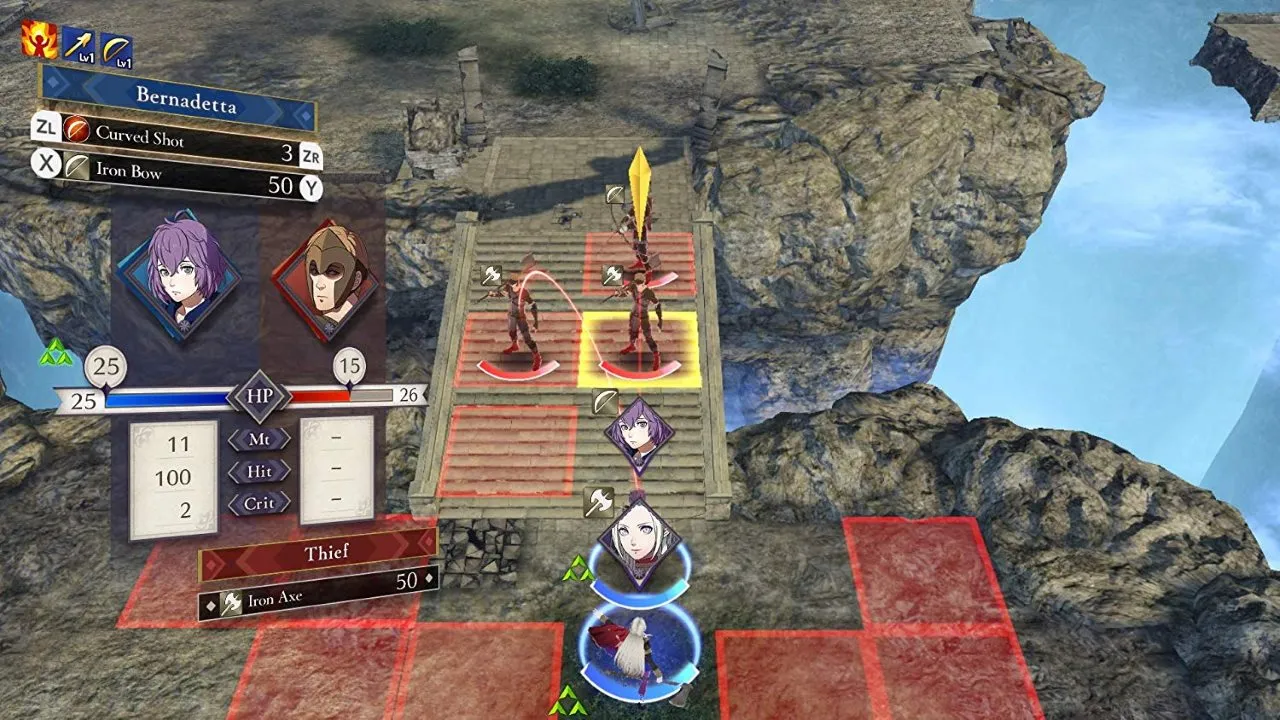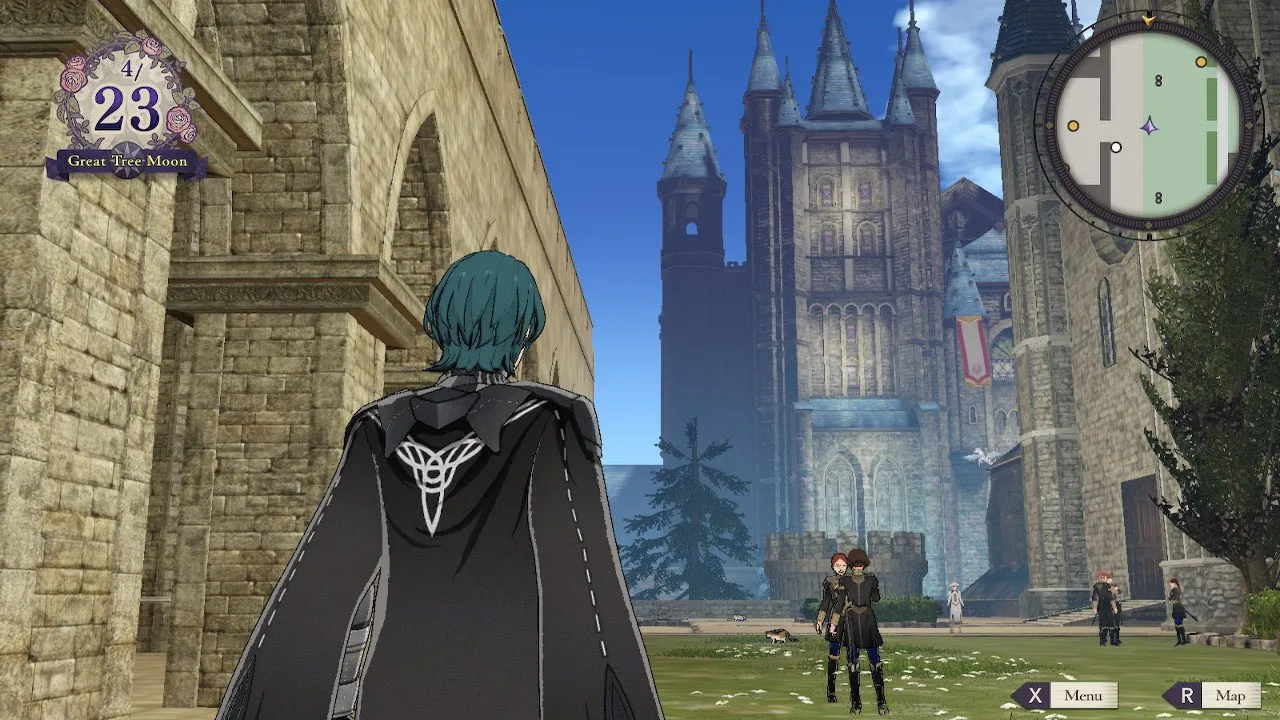Fire Emblem may have begun its life as a Japan-only phenomenon but ever since Awakening on the 3DS it has become one of Nintendo’s biggest franchises. Fire Emblem: Three Houses marks the franchise’s debut on the Switch and comes with a lot of anticipation and some high expectations, given the exceptional quality of the series’ handheld entries. Could this return to home consoles following a 12 year absence bring the series to even loftier heights than it achieved on handheld platforms? Does the Switch’s dual nature allow for a best of both worlds feel? While the answer to the first question is a clear “yes” the second is a bit murkier.
Fire Emblem: Three Houses is separated into two somewhat equal parts. In the first half you are the newly hired professor of Garreg Mach Monastery. In this role you teach and guide your students, while also recruiting others from the titular fellow houses. You’ll hold classes that boost particular stats, speak with students in between classes, and most importantly participate in battles, both real and practice. Operating off a calendar system that is reminiscent of Persona’s latest entries, each week/month brings new challenges and activities to choose from, but you have to manage your time wisely if you want to do everything and recruit everyone.

The core of the Fire Emblem series has always been its exceptionally designed turn-based combat, and Three Houses is no different. While there’s tons to do off the battlefield, sometimes offering more fun and excitement than the combat, the ultimate end of every month is still a large scale battle. Here Three Houses doesn’t expand too much on its predecessors, with combat still operating on similar systems as what we’ve seen before. Of course, it wasn’t broken before so it’s fine that it hasn’t been “fixed” too much.
While there used to be a pretty specific rock-paper-scissors dynamic to the fighting, with certain soldier types outclassing their rivals, now it’s more of an open mishmash of strategies. Sure, your Wyvern Riders are more susceptible to arrows, but it’s not a hard-and-fast rule, and you can fine tune your soldiers and tactics to compensate. There’s tons of stats, powerups, and abilities to unlock and equip, giving you the chance to truly decide how each of your characters will perform in battle. However, what usually ends up deciding who wins each fight, and the battle as a whole is your characters’ levels. Here’s where things can get a bit troublesome though.
The core of the Fire Emblem series has always been its exceptionally designed turn-based combat, and Three Houses is no different.
Fire Emblem: Three Houses is a really easy game. The series was once known for its brutal difficulty, especially with its permadeath system. More recent entries have pulled back on this though, and Three Houses eliminates it almost entirely. First of all, the Normal difficulty will have you overleveled throughout, while Hard won’t be too much more challenging. Permadeath is now an option right from the start, and even if you choose to use it you have an ever growing number of time rewinds. Get into a bad place in the battle, or just get unlucky? Rewind time and you’re good to go. It’s nice that my students/soldiers don’t get eliminated from the game because of the roll of a die, but it feels like more balance could have been in place.
Even with a low level of challenge Three Houses is a blast to play though. The story and its characters are the real star here, and players will find that they spend most of their time speaking with them or viewing their unlockable Support dialogue sequences. These are mostly explored in those “off days” where you roam around the Garreg Mach Monastery. There’s so much to do during these sessions, and you can tweak so much, such as your own stats or those of your students, that this might become the highlight of the month for many players.

But really it’s the interactions between characters that makes it so great. Even if you go in with the mentality that you just want to play the turn-based battles and everything else is secondary, you’ll surely find that these moments pull you in more and more as the hours pass. And this all comes together in the second half of the game where the lessons end and war truly begins. I won’t go into the details for fear of spoilers, but the game definitely takes a turn and it’s for the better.
With that said, it would have been better had players been given more control over where this story does go. As the name implies, there are Three Houses to choose from at the start of the game. This is the most consequential choice of all and most of the story that plays out afterward will be out of your control, depending on that initial decision. Even when things seem like they might be under your control, such as a choice for the next battle location or whether characters are worth talking to rather than fighting, things pretty much play out the same either way. And similarly, large chunks of the plot can be locked away, either by missing key deadlines or simply based on that initial choice for which House to go with. This leads to some very delightful replays, but for those who want the whole story in one go there will be disappointment somewhere along the way.
Still, even with only part of the plot fully displayed in one playthrough the journey is totally worth it. The battle system is as fine tuned and enjoyable as ever. The characters are engaging and memorable. And the overall story and universe will grip you from the opening moments to the closing credits. Each moment carries its own unique importance as you decide whether to enhance your characters to earn some new class unlock, send them into a risky battle, or simply spend time sipping their favorite tea. And as the game progresses into more and more mature territory, it never shies away from showing the consequences of those actions.
The Verdict
Fire Emblem: Three Houses is another must-have release for the Nintendo Switch. Featuring some of the most robust and enjoyable turn-based combat around, along with characters you’ll truly want to keep alive throughout the entire 50+ hour story. And with different paths to take, you can play through a different 50 hour game multiple times before feeling like the game has exhausted itself. Greater challenge in the battles would have been a nice addition at launch though, and some of that story does require at least one or two of those replays. Still, with a game this fun you’ll likely start up game 2 or 3 without a bit of hesitation.











Published: Sep 18, 2019 01:15 pm